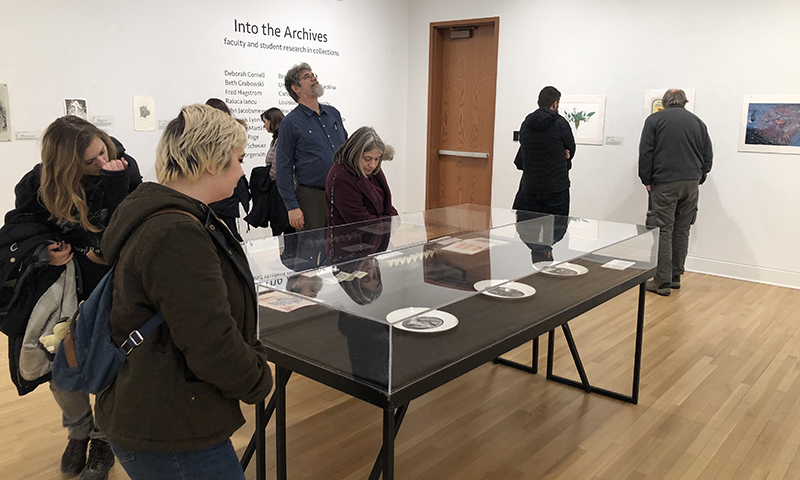Contemplating plants' purpose
Archival research, 'Doctrine of Signatures' inspire artist's work in Rueff Galleries exhibition

If a clove resembles a tooth, it can be used to treat tooth ailments. A plant with a veiny root system can fix vascular problems. A flower whose blooms resemble a human eye can help heal an eye infection.
Sounds crazy, right? But many years ago, humans believed that God – or “nature” – provided visible and sensory clues about plants’ possible uses.
This “Doctrine of Signatures” was the brainchild of 16th Century physician Paracelsus, known today as the “father of toxicology.” It is also the inspiration for an art exhibition, “Healing Phytography,” that will be open through Feb. 1 at Rueff Galleries in Yue-Kong Pao Hall of Visual and Performing Arts.
“I view my role as an artist as that of a researcher; exploring history, theology, and culture, often from a feminist perspective,” visiting assistant professor Jennifer Scheuer explained in an artist statement describing the exhibition. “I am interested in hidden knowledge and neglected narratives that support alternative views of history that change or question the traditions of hierarchy in science and social systems, and I am interested in different forms of knowledge and ways of seeing.
“Through this investigation, I seek to revitalize ideas that have been lost or forgotten, or do not conform to contemporary scientific culture, yet may continue to hold philosophical value.”
Scheuer’s exhibition – one of two that she currently has open at Rueff Galleries – features prints, drawings, book arts, found objects, and sculptures centered around the “Doctrine of Signatures.” She first began developing the works in 2012 and has continued to add pieces for multiple showings over the last several years.
Developments in modern medicine have caused the concept of observational healing to be largely dismissed as pseudoscience. And while she points out that some types of holistic medicine still rely upon elements of these treatments, Scheuer does not view the doctrine as valid science, either.
That’s not the point, anyway.
“The artwork visualizes historical and contemporary use of herbal medicine and visual signatures,” she said. "I do not personally make claims on its truth of healing."
Instead, she hopes that visitors will contemplate how we should interpret the visual similarities that sometimes exist between body part and plant.
“I’m interested in how the 'Doctrine of Signatures' is a theory of observation and could be interpreted as a mnemonic tool -- that once I learn this, it could be a memory device,” Scheuer said. "There's also an element of spirituality in the work. The phrase 'Doctrine of Signatures' was coined by Paracelsus and discussed in the relationship of developing ideas of science and spirituality. Is this the order of god or is this the order of something else -- biological structure? Or other ideas of interconnection? So there are many aspects to the theory that I find really interesting and compelling that's been driving my work."
Scheuer is curator and contributor to a second exhibition at the Galleries, this one based upon archival research. “Into the Archives” features 40 prints created by students and faculty researchers at 10 different universities.
“I’ve been really fortunate to have a lot of opportunities in undergraduate and graduate school where we observed collections,” said Scheuer, also a contributor to the “Return to Entry” exhibition that will open at Ringel Gallery on March 25 related to artists’ research at Purdue’s Barron Hilton Flight and Space Exploration Archives. “As an undergraduate, I had participated in a project studying collections of artwork at the Plains Art Museum in Fargo, N.D., where we viewed the artwork and made a piece in response -- not reproducing the artwork, but maybe using the composition, markmaking, or shapes seen in the artwork.”
Included among the contributors are students and faculty from Purdue, Boston University, the University of North Carolina, Carleton College, Louisiana Tech University, New York Academy of Art, the University of Tennessee, the University of Tulsa, Cornell University, and Indiana University. Among the exhibit's accomplished archival artists are Scheuer, Deborah Cornell, Beth Grabowski, Fred Hagstrom, Raluca Iancu, John Jacobsmeyer, Beauvais Lyons, Michelle Martin, Gregory Page, and Tonja Torgerson.
In their various works, the artists explored ways to respond to historical and archival information with new works that address current ideas. Scheuer's goal was to provide a unique exhibition opportunity to a group of student artists for their skill and thoughtful research, as well as to spotlight the accomplished educators for their use of historical influences in their works. She believes the collection is significant because it values the material available in local archives, and it also allows the artists to demonstrate the visual forms archival research can take.
“A few of the students in the exhibit take on the idea of what is an archive as a concept,” Scheuer said. “Can an archive be a gallery that is self-installed, or the idea of a collection and preservation of any series of objects with significance? Or the decontextualization of objects with different origins in the same location? It was great to see many different ways to think about the project.”